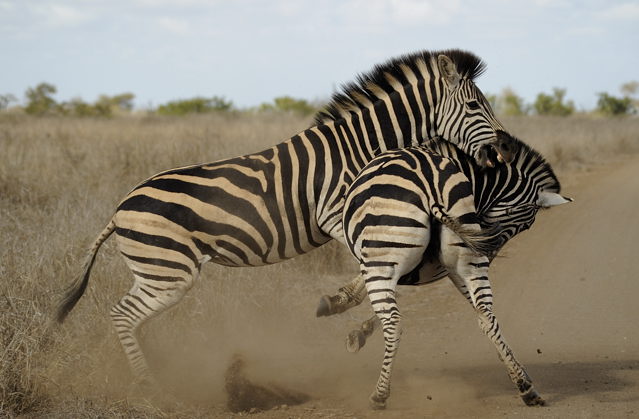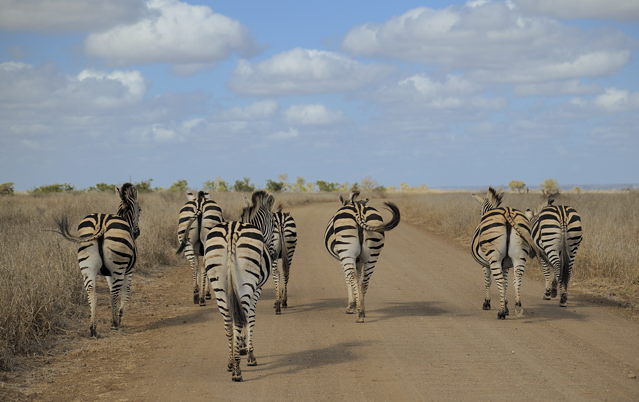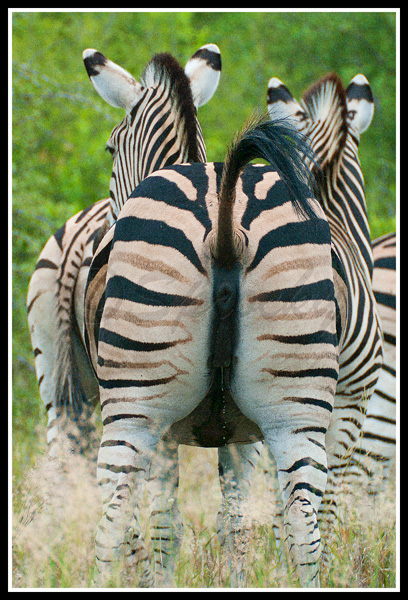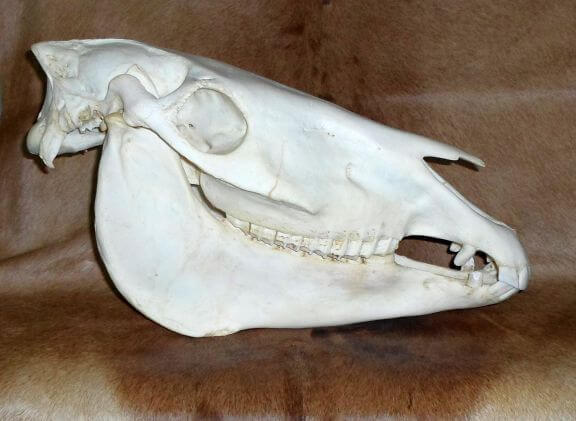This was taken at Rietvlei so very slim chance of it being as a result of a predator.Klipspringer wrote: ↑Thu Jul 02, 2020 9:45 amNote the tail!
Tourists are likely to attribute the loss of a tail to a predator attack, but the far more common cause is another zebra and I am not sure if mares would do it. I'll look into this and find out if there is female fighting in a group.
How to determine the gender of mammals from appearance or behaviour
- Flutterby
- Posts: 44150
- Joined: Sat May 19, 2012 12:28 pm
- Country: South Africa
- Location: Gauteng, South Africa
- Contact:
Re: How to determine the gender of mammals from appearance or behaviour
- Richprins
- Committee Member
- Posts: 76167
- Joined: Sat May 19, 2012 3:52 pm
- Location: NELSPRUIT
- Contact:
Re: How to determine the gender of mammals from appearance or behaviour
How interesting, Klippies! 
I wonder if the brown muzzle has anything to do with sex?
I wonder if the brown muzzle has anything to do with sex?
Please check Needs Attention pre-booking: https://africawild-forum.com/viewtopic.php?f=322&t=596
-
Klipspringer
- Global Moderator
- Posts: 5862
- Joined: Sat Sep 14, 2013 12:34 pm
- Country: Germany
- Contact:
Re: How to determine the gender of mammals from appearance or behaviour
Flutterby, I think the difference here is due to the legs more or less spread, you can see just more of the black band when the legs are more spread
There are no good sources about the difference, I found: male 1 inch wide; female 2-3 inch wide
What do others think?
-
Klipspringer
- Global Moderator
- Posts: 5862
- Joined: Sat Sep 14, 2013 12:34 pm
- Country: Germany
- Contact:
Re: How to determine the gender of mammals from appearance or behaviour
Fighting in Plains Zebra: Do females fight?
Source: https://www.researchgate.net/publicatio ... 0/download
Some pieces of this paper:
I think it's a safe assumption to identify fighting individuals as stallions.
(Do mare maybe fight off harrassing stallions ?)
?)
Female-female aggression is however possible when a new harem group is formed:
Source: https://www.researchgate.net/publicatio ... 0/download
Some pieces of this paper:
So females don't attack other females of their harem.In polygynous species, fights usually occur amongst males, who compete for access to mates. Fights tend to be rare in females, whose fitness is rather limited by energy and time investments in reproduction. For grazing ungulates in savannah, forage resources tend to be widely distributed
and difficult to monopolize. Therefore, the resource benefits to a female of winning an aggressive encounter are typically low, relative to the costs of fighting.
Certain equid societies contain stable female groups known as harems, each defended by a male. We find harems in plains zebra (Equus burchelli), mountain zebra (E. zebra zebra), and in both feral horses subspecies: E. ferus caballus and the Przewalski horse (E. ferus przewalskii). In addition to the stallion male and one to several females, the harem contains dependent offspring. Both sexes disperse on maturity, at approximately 2 years of age. In plains zebra, multiple harems form unstable herds, which may also contain bachelor males. The membership of a harem remains stable for months to years.
The females of plains zebra harems form stable dominance hierarchies in captivity and consistent leadership roles in the wild.
In equids, we can classify a continuum of aggression. Before any high-level aggressive acts, a pair of individuals will usually proceed through a series of escalating interactions. At the lowest level, we have supplants, and threats such as when an individual shakes its head at another, or moves towards it with ears back and head lowered. At the next level is kicking with one hind leg in the direction of a target individual, without necessarily making contact. If the contest escalates further, we may observe full-force kicking with both hind legs. Finally, zebras will chase each other, rear up to kick with forelegs, and attempt to bite the neck or hock of the opponent.
Bites, kicks or other aggressive acts are typically isolated events between plains zebra females. Violent fights occur regularly among male equids, but the female–female aggression we describe here is rare. This is the only major fight in our study of this plains zebra population, nor are we aware of other descriptions in the literature.
The presence of a new foal seemed to be the precipitating event of the fight (described in this paper). The incident began following a close encounter between the foal and the aggressing female, as the mother lay a short distance away. Throughout the fight, the mother appeared intent on blocking the aggressor’s path to her foal.
Over the course of a long-term study, researchers of animal behavior and ecology have the opportunity to witness rare, even aberrant, behavior.
I think it's a safe assumption to identify fighting individuals as stallions.
(Do mare maybe fight off harrassing stallions
Female-female aggression is however possible when a new harem group is formed:
- Lisbeth
- Site Admin
- Posts: 67658
- Joined: Sat May 19, 2012 12:31 pm
- Country: Switzerland
- Location: Lugano
- Contact:
Re: How to determine the gender of mammals from appearance or behaviour
 © Dewi
© DewiZebras fighting, ergo males! The black stripe seems broad in the animal on the right-hand side
"Education is the most powerful weapon which you can use to change the world." Nelson Mandela
The desire for equality must never exceed the demands of knowledge
The desire for equality must never exceed the demands of knowledge
- Lisbeth
- Site Admin
- Posts: 67658
- Joined: Sat May 19, 2012 12:31 pm
- Country: Switzerland
- Location: Lugano
- Contact:
Re: How to determine the gender of mammals from appearance or behaviour
 © Dewi
© Dewi"Education is the most powerful weapon which you can use to change the world." Nelson Mandela
The desire for equality must never exceed the demands of knowledge
The desire for equality must never exceed the demands of knowledge
- Lisbeth
- Site Admin
- Posts: 67658
- Joined: Sat May 19, 2012 12:31 pm
- Country: Switzerland
- Location: Lugano
- Contact:
Re: How to determine the gender of mammals from appearance or behaviour
Here the stripe is very visible and no doubt that it's a female  The stripe does not look very broad though
The stripe does not look very broad though 
 © Sprocky
© Sprocky
 © Sprocky
© Sprocky"Education is the most powerful weapon which you can use to change the world." Nelson Mandela
The desire for equality must never exceed the demands of knowledge
The desire for equality must never exceed the demands of knowledge
-
Klipspringer
- Global Moderator
- Posts: 5862
- Joined: Sat Sep 14, 2013 12:34 pm
- Country: Germany
- Contact:
Re: How to determine the gender of mammals from appearance or behaviour
-
Klipspringer
- Global Moderator
- Posts: 5862
- Joined: Sat Sep 14, 2013 12:34 pm
- Country: Germany
- Contact:
Re: How to determine the gender of mammals from appearance or behaviour
I think this is the canine (orange circle)!
In females the canines are rudimentary or absent, but they are present in the males.
Here a skull

We have at least one male.
But who knows how a stallion will guard his harem, maybe this is the way he tries to keep the mares if they wander off
Or they are two males?
Is this the only photo of the situation, Lisbeth?
- Lisbeth
- Site Admin
- Posts: 67658
- Joined: Sat May 19, 2012 12:31 pm
- Country: Switzerland
- Location: Lugano
- Contact:
Re: How to determine the gender of mammals from appearance or behaviour
Unfortunately, yes!
"Education is the most powerful weapon which you can use to change the world." Nelson Mandela
The desire for equality must never exceed the demands of knowledge
The desire for equality must never exceed the demands of knowledge


